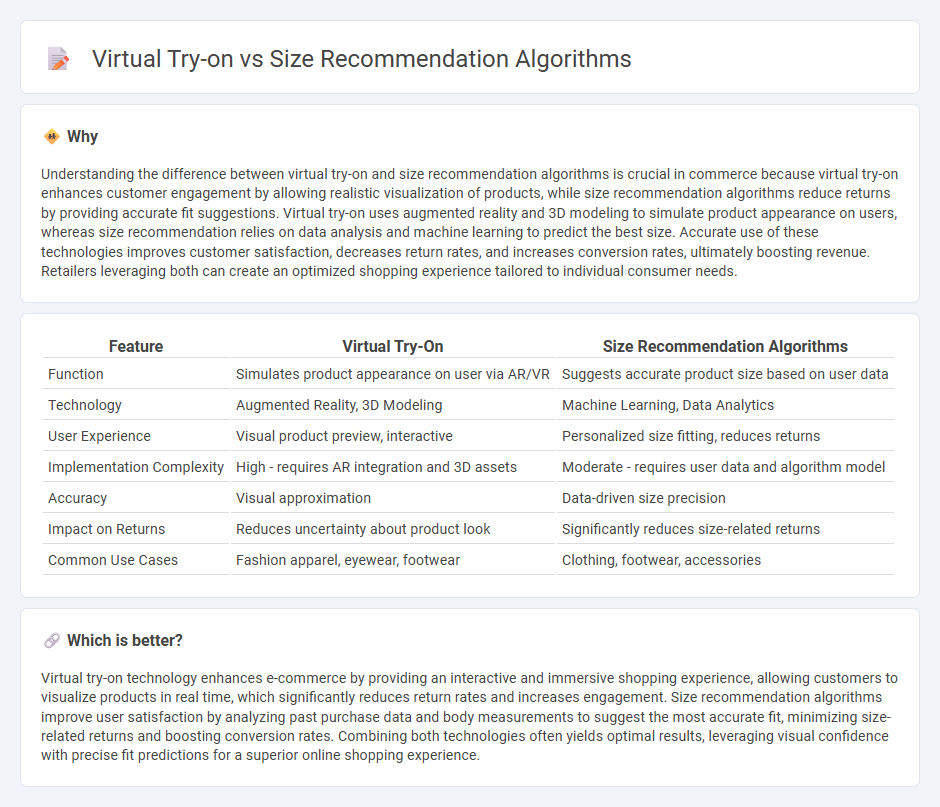
Virtual try-on technology enhances e-commerce by allowing customers to visualize products on themselves through augmented reality, increasing confidence in purchases. Size recommendation algorithms analyze past purchase data, body measurements, and return patterns to suggest the best-fitting size, reducing returns and boosting satisfaction. Explore how integrating virtual try-on and size recommendation algorithms can transform the online shopping experience.
Why it is important
Understanding the difference between virtual try-on and size recommendation algorithms is crucial in commerce because virtual try-on enhances customer engagement by allowing realistic visualization of products, while size recommendation algorithms reduce returns by providing accurate fit suggestions. Virtual try-on uses augmented reality and 3D modeling to simulate product appearance on users, whereas size recommendation relies on data analysis and machine learning to predict the best size. Accurate use of these technologies improves customer satisfaction, decreases return rates, and increases conversion rates, ultimately boosting revenue. Retailers leveraging both can create an optimized shopping experience tailored to individual consumer needs.
Comparison Table
| Feature | Virtual Try-On | Size Recommendation Algorithms |
|---|---|---|
| Function | Simulates product appearance on user via AR/VR | Suggests accurate product size based on user data |
| Technology | Augmented Reality, 3D Modeling | Machine Learning, Data Analytics |
| User Experience | Visual product preview, interactive | Personalized size fitting, reduces returns |
| Implementation Complexity | High - requires AR integration and 3D assets | Moderate - requires user data and algorithm model |
| Accuracy | Visual approximation | Data-driven size precision |
| Impact on Returns | Reduces uncertainty about product look | Significantly reduces size-related returns |
| Common Use Cases | Fashion apparel, eyewear, footwear | Clothing, footwear, accessories |
Which is better?
Virtual try-on technology enhances e-commerce by providing an interactive and immersive shopping experience, allowing customers to visualize products in real time, which significantly reduces return rates and increases engagement. Size recommendation algorithms improve user satisfaction by analyzing past purchase data and body measurements to suggest the most accurate fit, minimizing size-related returns and boosting conversion rates. Combining both technologies often yields optimal results, leveraging visual confidence with precise fit predictions for a superior online shopping experience.
Connection
Virtual try-on technology enhances online commerce by allowing customers to visualize products on themselves, while size recommendation algorithms predict the best fit based on user data. Both technologies rely on machine learning and computer vision to personalize the shopping experience, reducing return rates and increasing customer satisfaction. Integrating these tools creates a seamless interaction that boosts conversion rates in e-commerce platforms.
Key Terms
Fit Prediction
Size recommendation algorithms leverage historical purchase and return data to predict the best garment size for customers, improving fit accuracy and reducing returns. Virtual try-on technology uses augmented reality and 3D modeling to simulate how clothing fits on a user's body in real time, enhancing the visualization of fit and style. Explore how these technologies revolutionize online shopping by optimizing fit prediction for a more personalized experience.
3D Body Scanning
Size recommendation algorithms leverage user data and machine learning to predict the best fit, primarily using 2D or basic 3D measurements, whereas virtual try-on technologies employ advanced 3D body scanning to create realistic digital avatars for try-before-you-buy experiences. 3D body scanning enhances accuracy in both methods by capturing precise body dimensions, improving fit prediction and visualization in virtual environments. Discover how integrating 3D body scanning is revolutionizing online shopping experiences and boosting customer satisfaction.
Augmented Reality
Size recommendation algorithms analyze user body measurements and past purchase data to predict the best clothing fit, enhancing online shopping accuracy and reducing return rates. Virtual try-on leverages augmented reality (AR) technology to overlay digital clothing on a user's live image, offering an interactive and immersive fitting experience. Explore how AR-powered virtual try-on tools revolutionize fashion retail by blending precision sizing with engaging customer experiences.
Source and External Links
Virtual fitting rooms and size recommendation - Sizebay - Size recommendation algorithms often use statistical methods comparing user-inputted body measurements with past purchase and return data to recommend the best garment size for similar users.
Recommending Product Sizes to Customers - Amazon Science - Amazon uses latent factor models that learn true physical sizes of customers and products from past purchase and return data to predict the fit outcome and recommend sizes efficiently.
Size Recommendation Tools Guide: Best Options for Fashion - Modern size recommendation tools employ AI-based photo or video body scanning technologies to extract precise measurements and match them against product data to guide customers to the right size quickly and accurately.
 dowidth.com
dowidth.com